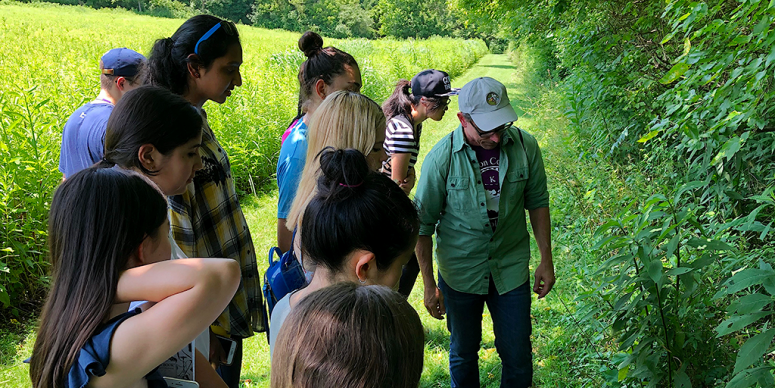Writing in the Woods

From Kenyon News - July 12, 2018
The high school students moved cautiously off the trail and across the green and damp hillside on their quest to classify a tree at the Brown Family Environmental Center.
Compound leaves? Bark type? Size? Professor of Biology Drew Kerkhoff sent the group on the assignment as part of this summer’s new Kenyon Review Young Science Writers Workshop, devoted to writing about nature and science. Kerkhoff told the students they were walking in the footsteps of German writer Johann Wolfgang von Goethe, who explored botanical classifications in some of his essays.
“Our categories don’t always fit with nature. Nature works its way around our definitions,” Kerkhoff told the students. “And so we are left with metaphor — something that connects to our meaning but is not literally what the thing is. A lot of the things we do in science are to create a metaphor.”
The 20 high schoolers in the science workshop also spent a morning creating a story out of nouns and verbs that they wrote on cards and then were randomly reassigned. Aadhya Ramineni, a rising senior at Cincinnati Country Day School, got some friendly griping for putting the word “satchel” into the exercise.
“Most of the people here have taken Advanced Placement science classes, but that’s not me. I’m more philosophical,” Ramineni said. Her favorite part of the two-week program? “I liked that I got to work in a lab here without having any grade on it. And I felt comfortable being able to ask any question I wanted. That was really good for me.”
This fall, Ramineni will be editor of her school newspaper. In preparation, she attended a breakout session on science journalism, while other workshop sessions focused on writing scientific papers or poetry about scientific themes.
Kenyon Review editor David Lynn ’76 P’14 and his staff have grown the Young Writers Workshop program from 12 students in 1991 to 226 students this summer. Because of its popularity, less than half of applicants to the workshops are accepted. The Review also has a growing pool of scholarship money to bring a diverse group of top students to Gambier from across the nation regardless of economic background. In 2018, 61 percent of Young Writers participants identified themselves as students of color.
Lynn is excited to add science writing to the transformative experience that Young Writers gives teenagers. “This is truly life changing,” he said. “These kids, as talented as they are, are used to being loners. They are used to being off by themselves and looking on as other kids do their thing, because that’s what writers do.
“Here, at Kenyon, for two weeks in the summer, they are surrounded by other kids just like them. They fall in love with each other, with Kenyon and with the process.”
Cindy Xie came from Los Angeles to learn that process.
“I was hoping to learn more about writing as a craft, because usually I just do it for myself as a singular thing,” the rising high school junior said. “What I’ve learned is that a large part of writing is just getting started and working through the frustrations.”
“We want to dispel the idea that a muse will land on their shoulder to whisper words in their ear,” said Anna Duke Reach, director of programs at the Review. “It’s hard work to be a writer. You have to seatbelt yourself in a chair and focus. And the revising, revising, revising is something they don’t do much in high schools anymore.”